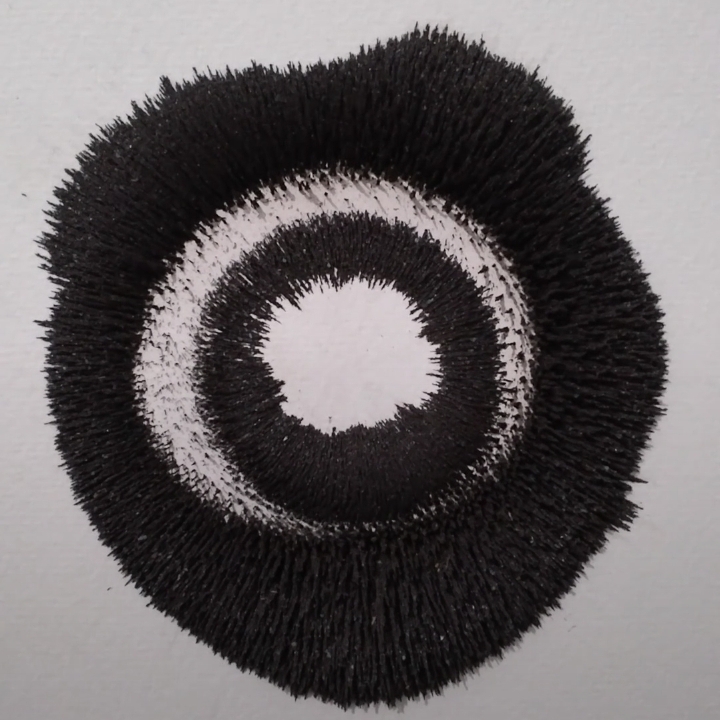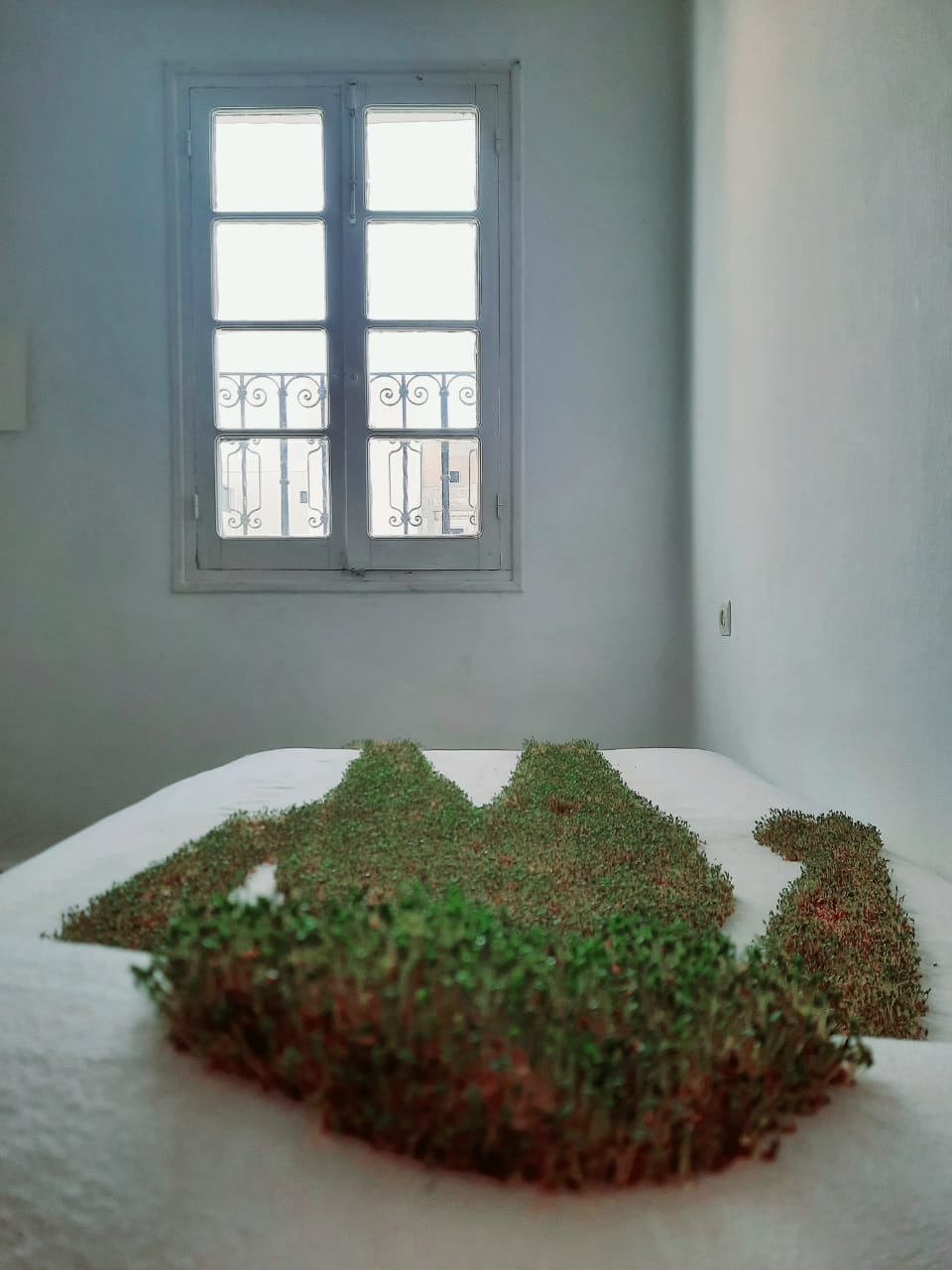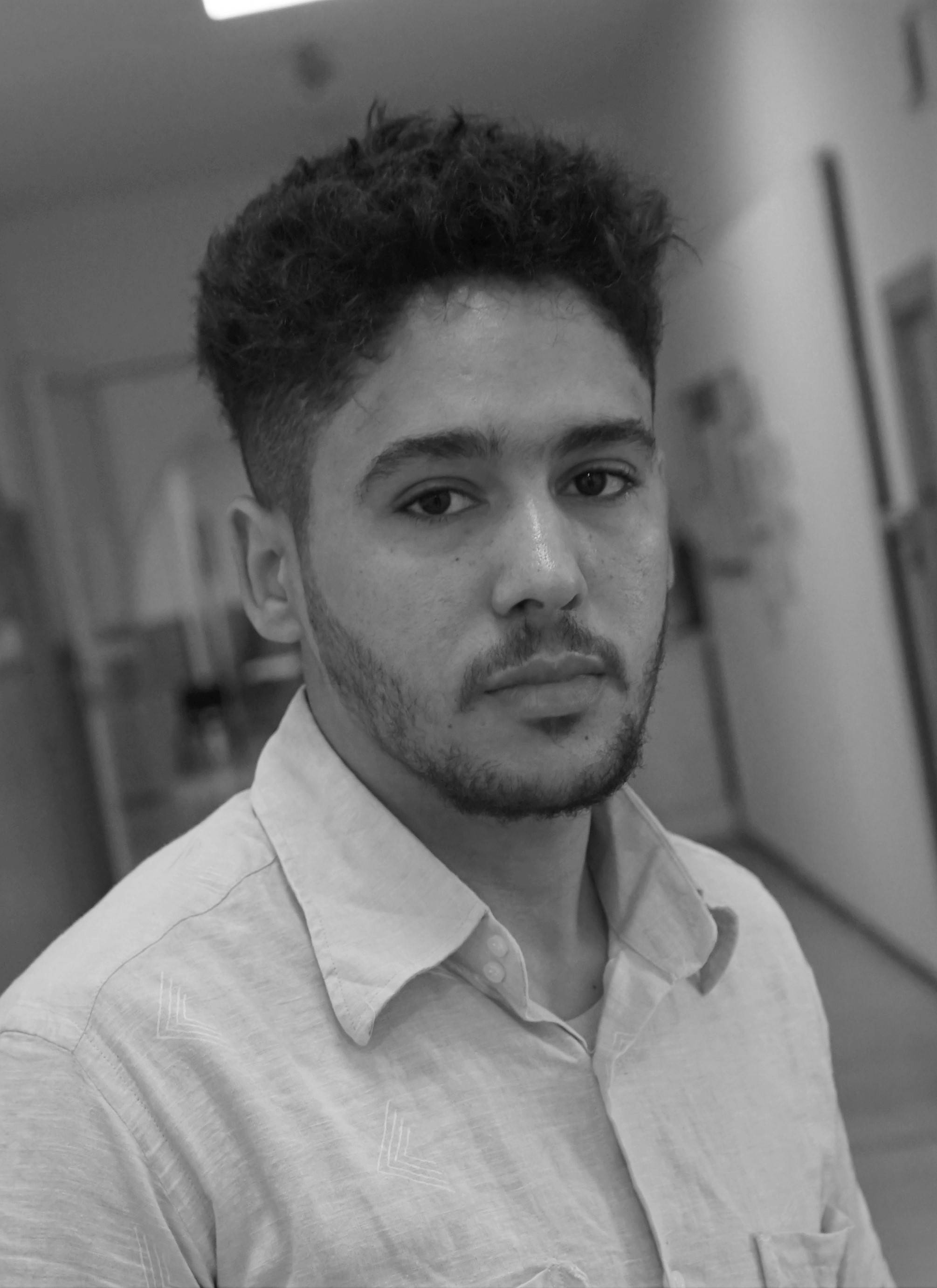Review #5: Three Ephemeral Artistic Positions
Mouad Elbissaoui
Artists Safae Elkadi, Oumayma Abouzid Souali, and Ayman Errachidi all participated in “DAYZ” artistic residency, held in an independent space in the city of Tetouan, where they had an open studio event between October 29-31, 2022.
Safae Elkadi, Oumayma Abouzid Souali, and Ayman Errachidi, are three artists who graduated in 2021 from the National Institute of Fine Arts in Tetouan. They studied together, and their identities and artistic knowledge were formed in one environment, but they differed and diverged. There were however many common threads in between, by virtue of them being informed by the same references that produced their artistic styles. I was observant of their routines during their last year of study, when I was a third year student, and our friendship allowed me to frequent their shared studio space. I can now see development of what I witnessed at the time with their practices, interests and ways of working.
Ayman occupies the largest space, devouring space, taking risks and daring with materials and sizes. This is justified by his questions on the geographical area where he grew up, the sandy desert. As for Safae, she built a plastic room inside the studio where she works, with “birth hall” written on the door. As viewers we are not allowed to enter, but we understand the spiritual connection to her artistic experiences, which explains her approach to visual research by trying all possible materials and mediums to satisfy her artistic taste. Oumayma is usually busy in her small corner either dotting her many white balls, singing or reading. She often summons the audience to help mark the balls with dots, and share that sense of the endless unknown with her.
In general, I believe they share the same desire to produce modest artistic conditions. What surprises us, and takes us to sublime sensual points, is a circumstance that is balanced, clear, and mitigated by many reasons. It answers one question, and does not evade motives in order to prove itself. This is how I see work in a place and time that can embrace it with comfort and familiarity. It feels as if a painting has slept hanging on the wall that is displaying or domesticating it. It may be difficult for us, at first glance, to stand in front of an action and circumstance (time - place) that may harmonize, and justify our surprise with one and not the other. If we reflect on it carefully, this connection cannot be overlooked or ignored.
This is what the three artists achieved in the open studio event based on their research of two months of a joint residency, which they chose a year after graduation. Through it they revived the time of collaborative work in the institute’s studios, knowing that they are forced to cross paths, so that nothing remains of their experiences except from traces and memories. They called themselves and their residence "DAYZ", which means "passer" in the moroccan dialect, different from its phonetic meaning in English as "DAYS". They let us pass through their living space and discover their artistic research in an apartment separated into three different worlds, all the more so for one space. “DAYZ” is a well-balanced, elegant apartment, consisting of three rooms with several areas and floor levels, which moves us from one space to the other in anticipation of seeing the forthcoming artworks. The main corridor brings us to the midpoint, where we remain free to choose which of the rooms to explore.


The open studio of “DAYZ” artistic residency. Photo: Mouad Elbissaoui

Work by Safae Elkadi. Photo: Mouad Elbissaoui
Safae Elkadi occupies a room that is longer than it is wide, with forty centimeters high floors, pure white walls, and a low window in the left corner. The room includes works and poetic experiments through which the artist monitors various aesthetic and kinetic possibilities for iron crumbs within magnetic fields. This visual research includes necessary knowledge of physics in order for the work to become a medium capable of accommodating the artist's visual style. The surprise that hits us in front of these trials accomplished by Safae, is very close to the astonishment of a student who witnesses a scientific experiment for the first time. However, I think that surprise should not depend on the idea of viewing the work for the first time only! Contrary to what we may feel at first glance, where the artwork’s physical experience transcends to the sensory, and the artist's intention towards producing a certain meditative experience appears clear, it is not based on the force of movement produced by magnetic fields but rather on visual possibilities and questions that go beyond that. It is dynamism and time that moves the suspended artwork from its classical concept of capture and freeze, to the creation of continuous and/or recurring change within the work.
It is at this point where most of the artworks presented in the three spaces meet and converge. In the opposite room on the left, with a window on its right wall, Ayman Errachidi chose to display a piece that encourages us to return to explore in a different form. It comprises a body grown from cress seeds on a bed placed opposite the window, and a group of drawings made with the same seeds. Through his work, Al-Rashidi raises questions about natural geographical topics which form part of the human identity and personality. These questions are based on his attachment and belonging to the geography of the southern Moroccan desert, and his investigation of the nature of sand in evident in his practice. When he paints with seeds, the scent of water is only sufficient to spread its greenness. This is how we also feel the body that is lying on the bed, which is his body in the first place, as if he is forcing a body of sand to turn green.

Work by Ayman Errachidi. Photo: Mouad Elbissaoui

Work by Oumayma Abouzid Souali. Photo: Mouad Elbissaoui
As for Oumayma Abouzid Souali, she picked the smallest, dimmest, and most intimate room. It is in the heart of the apartment, reducing the impression of spaciousness and as a result amplifying the sense of warmth. I really don't know who chose the other first, whether it was Oumayma or the room. It seems though that the space has shaped what she has been preparing and is presenting for us. The character of the room is influenced by its size, lighting, and its Bedouin feel, and Omaima’s artistic production is influenced by the holistic arrangement of space in sound, size, and lighting. Her exploration of the space is visible through installations that integrate different mediums, altering our experience of the room we entered and our anticipation. Voices are heard emanating from the ground below, and visuals of a re-enacted image with elements of the artist's grandfather's countryside house can be seen. These senses combined reduce both the distance between us and the countryside, and between moments gone by and the very moment we contemplate this work. It is as if the space was transported and disassembled from a time and place, then reconstructed with an artistic approach that is open to new physical possibilities.
Overall, the three experiences have allowed us, in passing, to absorb the worlds of artists who crossed through these spaces to create original, simple and ephemeral artistic positions. They tell what they intend to tell, express without the burden of distraction, and spare us from faltering to taste.

Mouad Elbissaoui
is a conceptual artist born in Marrakech in 1996. He graduated from the National Institute of Fine Arts in Tetouan. His artistic works reveal constructed concepts and perceptions of contemporary political consciousness. His artistic practice resorts to writing, highlighting the topical and stylistic concerns common to artists of his generation and surroundings, clarifying the extent in which it forms collective artistic consciousness.